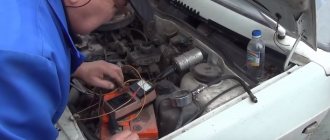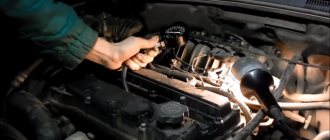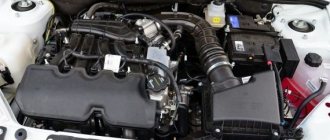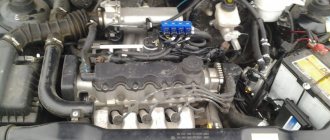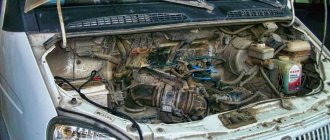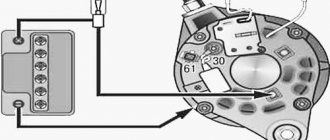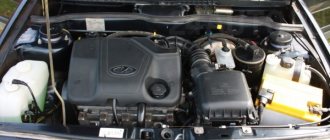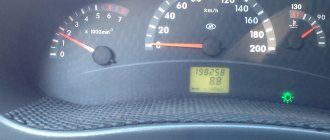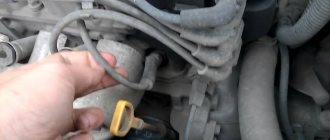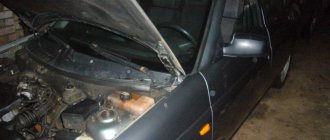The good performance of the VAZ 2114 engine is largely due to the good formation of the spark and fuel mixture. If one of these parameters is violated in a car, the engine may behave unpredictably.
Quite often, Samara 2 owners are faced with the problem of a stalling engine, and it occurs for many different reasons. This problem can really fray the nerves of those who are trying to solve this problem on their own.
In this article we will describe in detail how to independently diagnose the cause of engine tripping and failure of one or even two cylinders on a VAZ 2114.
Troit or not
How to understand that the engine in a VAZ 2114 is malfunctioning is quite simple, you just need to carefully listen to the operation of the internal combustion engine, and when driving, it is quite difficult not to notice that one of the cylinders is not working in the car.
Signs of a stalling engine:
- Loss of power;
- Vibrations;
- The engine shakes;
- Pops from the exhaust pipe;
If your car shows such signs of malfunction, most likely one or even two cylinders are not working.
SIGNS AND REASONS OF “ADJUSTMENT”
Signs: Engine trouble: what is it, and what are the signs to identify this malfunction? You can understand that the internal combustion engine is malfunctioning by the following signs:
- At idle speed, the engine operates unevenly, jerking periodically;
- The car does not develop the required power when driving;
- The car drives jerkily, when you press the gas pedal, there are gaps in operation;
- The exhaust from the muffler is uneven, with interruptions, pops and shots are possible;
- Fuel consumption increases.
Increased fuel consumption costs money.
Reasons: There are many reasons why the engine misfires. There are such nuances that even experienced technicians do not immediately determine the nature of the malfunction. But the most common cylinder failures are the following (starting with the elementary ones):
- The candle does not work;
- The high-voltage wire is broken;
- The ignition coil has failed;
- The control unit is faulty;
- There is an air leak in the intake manifold;
- Exhaust valve burnt out;
- The cylinder head gasket is broken;
- The compression rings on the piston are broken,
- The piston itself has burned out, or the bridge on the piston between the compression rings has burst.
This article is about the VAZ 2114 car, so carburetor malfunctions are not considered, since this device was not installed on the 2114 model. This brand of car has a fuel system with distributed injection (injector), and the answer to the question of why the engine stalls may be hidden in this system.
How to find out which cylinder is not working
In order to find out exactly which of several cylinders is not working, you can use two methods: checking through an OBD scanner and the good old test by elimination. Let's consider both options in more detail.
Scanner check
You need to purchase a special scanner ELM327, which connects to the OBD2 connector. Then the car diagnostic application is downloaded on the phone and paired with the scanner via Bluetooth.
The scanner reads errors from the electronic control unit through a connector and indicates a malfunction. Thus, it is possible to determine which cylinder has failed.
Checking by elimination
This check involves listening to the sound of the engine. If the car is shaking, then you need to open the hood, remember the sound of the internal combustion engine and, one by one, using pliers with insulated handles, remove the caps of the high-voltage wires from the spark plugs.
When the cap is removed from the working cylinder, the sound of the internal combustion engine will change and the engine speed will drop. This is a sign of normal operation of the cylinder, but if the sound of the engine does not change when the cap is removed, this means that this particular cylinder is not working.
Symptoms of a problem
If you know about the main signs and symptoms of a motor malfunction leading to tripling, it will be much easier for you to solve the problems that arise.
There are several signs in total.
- The engine runs rough at idle, shaking and vibrations occur, which are clearly felt inside the cabin. This phenomenon cannot be confused with anything and the verdict is clear - one of the cylinders has failed. This symptom appears even when the unit is broken.
- Blackening of the electrode for spark plugs, presence of soot and soot. It is not enough to simply replace the spark plugs with new ones, since this does not eliminate the cause of soot formation.
- The exhaust changes its sounds. When tripping, the exhaust sound literally shakes the car. Experienced drivers notice this quickly and easily.
- The appetite of the power unit is noticeably growing. There can be many reasons for increased consumption, so a full diagnosis will be required.
- Dynamic performance decreases, speed and power drop. At low speeds it is not difficult to notice when picking up speed. But this can be caused by cylinder failure, that is, tripping, or other reasons.
- The revolutions are floating. This is easy to notice by looking at the tachometer needle. Changes, that is, fluctuations, can be serious or minor, in the range of 100 revolutions.
- When accelerating, you can feel the engine jerking in any gear.
To understand why the engine stalls at idle or in gear, you need to understand the possible reasons for this phenomenon.
Causes
The reasons for engine tripping are different. But they are most often caused due to the failure of one of the following units:
- Ignition system;
- Candles;
- High voltage wires;
- Vacuum booster;
- Air filter;
- Distributor;
- Incorrect adjustment or burnout of valves;
- Piston rings.
We recommend: Where is the Engine Number on Renault Logan
Now let’s take a closer look at the reasons and actions you can take in a given situation.
The revolutions are floating
| Cause | Your actions |
| The ignition was set incorrectly | It’s not uncommon for an engine to misfire because the ignition was set incorrectly. The problem is determined by skipping a beat, the appearance of popping noises, and bouncing of the engine. Listen to how the motor works. If the tripping occurs at idle, but when you start driving and increase the speed, the problem goes away, then the ignition is too early. It needs to be adjusted. |
| Vacuum booster problem | It may be damaged, the tightness of the diaphragm or valve may be compromised. This leads to the appearance of air inside the system, the mixture becomes “leaner” and does not ignite properly. As soon as there are literally 2 omissions, the candle will get wet and will not be able to work. If there are problems with the amplifier, the engine will fluctuate at idle, when the engine is hot and cold |
| Spark plug | Another common problem is engine tripping, accounting for about 50 percent of all cases. To solve the problem, periodically inspect the spark plugs, clean them and change them. Moreover, it is recommended to perform the replacement as a complete set, and not just each candle individually |
| High voltage wires | If breakdowns occur in one of the high-voltage circuits, the spark will not be able to reach its spark plug. As a result, the motor stalls and does not work properly. To check, turn off the lights, start the engine and watch the area from the distribution coil to the spark plugs. If a spark appears in the gap, this indicates the presence of a hole in the capacitor or wire insulation. A temporary solution is electrical tape, but then the wire must be replaced |
| Air filter | If the air filter becomes clogged and dirty, the engine will simply suffocate due to lack of oxygen. This situation is relevant for those who, when changing the oil, ignore the recommendation about the need to simultaneously replace the air filter. As a result, the spark plugs are flooded, the mixture becomes lean, and the engine suffers. Just change the filter and the problem will go away |
| Piston rings | Piston rings rarely become deformed, but this situation cannot be ruled out. To make sure everything is fine with this unit, perform a compression test. If the compression level in one of the cylinders is too low, try adding a little oil to it. If the problem goes away, then the reason is definitely in the rings. They need to be replaced |
| Valves | If valve clearances are violated, the entire system suffers. Because of this, periodically one of the cylinders cannot receive the required amount of air-fuel mixture. With such a malfunction, the engine will misfire at idle, when the engine is hot, when the engine is cold, and when driving. To fix the problem, you need to remove the cylinder head and adjust the valves in accordance with the instruction manual for your VAZ 2110 with the engine installed on the car. Different engines have their own nuances |
| Distributor | Not very often, but the distributor also sometimes causes the engine to trip. This assembly has three weak points - the turntable bearings, shafts and bushings. Over time and as the vehicle is used, they wear out. Therefore, if the culprit is the distributor, try replacing it completely or carry out partial repairs with a repair kit, replacing worn elements |
| Burnt out pistons or valves | A problem we don't want anyone to face. This is a serious engine failure that will require a complete repair of the power unit. The main difficulty is the need to disassemble the engine and visually inspect the pistons and valves. Carry out such a check only if all previous measures did not produce results and did not allow you to identify the culprit |
Checking pistons and valves for burnout can only be carried out by a specialist with sufficient experience. It is not recommended for beginners to carry out such activities on their own.
We recommend: How to check the ABS sensor
Engine trouble is a simple symptom that can appear as a result of all sorts of breakdowns and defects in your engine. Therefore, your task is to find the cause of the tripping and promptly eliminate it. If you delay repairs, the consequences can be catastrophic for your car and budget.
Reasons why the engine starts to stall
Engine trouble occurs for several reasons. When a cylinder fails in an internal combustion engine, it greatly affects its operation and it is simply impossible not to notice this.
List of reasons why the internal combustion engine fails:
- Wear of high-voltage wires;
- Failure of spark plugs;
- The ignition module is faulty;
- Clogged fuel injectors;
- Valve burnout;
- CPG wear;
- Failure or incorrect operation of the DPKV;
- ECU failure;
As you can see, there are quite a few reasons for the appearance of this malfunction on the VAZ 2114, and in order to understand which of them is the source of the breakdown on your car, you need to check all points and exclude some points in order to come to one conclusion.
No spark or weak sparking
If a spark appears, then move the spark plug away from the mass by 1 cm and repeat the previous action again. If the spark has noticeably weakened and is barely visible, then we have poor sparking.
Poor spark formation or no spark at all may be caused by the following faults:
- high resistance of high-voltage wires, or wire breakage;
- To do this, you need to check the high-voltage wires and replace them (the high-voltage wires may not be installed correctly);
- ignition module malfunction - check and replace;
- ECU malfunction - have it repaired or replace it with a new one;
- DPKV malfunction - its malfunction will be indicated by an error that can be read using the BC or carried out diagnostics. A non-working sensor needs to be replaced;
- again, the timing belt could have slipped a couple of teeth - disassemble it and reinstall it according to the timing marks.
If there is a spark, and a good one, then all that remains is to look at the rings, compression, valves, injectors, which have already been described above. We wish you good luck in finding your problem!
Why does the VAZ 2114 cylinder not work?
In order to make sure exactly why the cylinder failed, it is necessary to check all the elements that could cause the cylinder to fail.
Always start with the spark plugs
Checking the spark plugs
Checking the performance of the spark plug must be done on a special stand or by unscrewing the spark plug and putting it on its cap and placing it on the valve cover. Then ask someone you know or passerby to turn the starter. A spark should appear on the spark plug periodically. If it is missing, then the reason is in the candle.
It is better to check the spark plug on a cylinder that was initially in working condition.
Checking wires
High-voltage wires are made of special material with high insulation resistance to ensure reliable transmission of high voltage to the spark plug.
It is necessary to inspect the wires for breaks or damage to the insulation. The wire cap must be securely fixed to the spark plug and press the contact tightly against it.
If the wires have a characteristic worn appearance, they must be replaced.
Ignition module
The ignition module on the VAZ 2114 has two coils inside, each of which regulates the voltage supply to two cylinders. For example, the first coil is responsible for the operation of 1-4 cylinders, and the second is responsible for the operation of 2-3 cylinders.
From this we can conclude that if two cylinders, namely 1-4 or 2-3, do not work at once, then most likely there is a breakdown in the ignition module.
You can accurately verify this by removing this part from another car and installing it on a faulty car for testing.
Clogged fuel injectors
The injectors spray fuel into the combustion chamber. The VAZ 2114 has one injector for each cylinder. If one of the injectors becomes clogged, then the operation of this cylinder becomes impossible due to the lack of fuel mixture in it.
Checking the injectors can be done by measuring the fuel pressure and opening one of the injectors. The best way is to remove the fuel rail and wash the injectors.
Valves problem
Burnout of valves significantly affects the operation of the entire internal combustion engine. It occurs due to incorrect valve adjustment, namely when the valve is pressed and constantly open.
Also, if the valves are not adjusted correctly, engine tripping may occur.
You can check this by measuring the compression. To do this, instead of a spark plug, we screw in a compression gauge (a device for measuring compression in the engine) and the starter turns several revolutions. If there is no compression or it is much lower, then most likely the valve in the internal combustion engine is burnt out or incorrectly adjusted, or the CPG is worn out. To prevent wear on the CPG, it is necessary to drop some engine oil into the engine and measure again. Engine oil helps increase compression when the piston and rings wear. If there is no compression upon repeated measurement, then there is a problem with the valve.
DPKV failure
The sensor that takes readings from the rotation of the crankshaft is called DPKV. It determines the position of the piston in the engine and sends signals to the ECU. The sensor is directly involved in spark formation. If it fails, there will be no spark on all four cylinders and the engine will not be able to start.
Breakdown in the ECU
The control unit contains an electrical board with a large number of radio elements. Each element is responsible for a specific sensor. Special keys are responsible for the operation of the ignition module, which quite often fail, which makes it impossible to supply a spark to a certain cylinder.
If the engine in your car is not working, and you have tried all the methods, then it is best to contact an experienced electrician who can diagnose a breakdown in the engine control unit.
VAZ 2114 troits at idle
If the engine stalls when cold (at idle), there are three possible reasons:
- problems with fuel supply;
- problems in the ignition system;
- valves are poorly adjusted.
In this situation, it is necessary to: a) do a general flushing of the fuel system, and also clean the injectors using ultrasound;
b) change the spark plug, a set of high-voltage wires and diagnose the ignition coil; c) adjust the valves and, if necessary, replace them.
What to do if the engine stalls when hot. In this regard, professional auto mechanics believe that the reasons are the same as in the first case. At idle speed when the engine is warm, one of the cylinders may stop working due to malfunctions in the fuel supply system or lack of spark. The procedure is the same as for failures on a cold engine.
Although in a professional environment it is believed that engine tripling is a fairly rare failure, nevertheless, discussion of this problem on automobile forums, including for the VAZ 2114, suggests that these problems exist due to a large list of possible reasons for such failures, this becomes a serious headache for the motorist who encounters it. However, if you approach solving this problem calmly and thoughtfully, without trying to haphazardly replace one thing or another, it is quite possible to solve this problem.
When the term “missing” is used in a conversation between car enthusiasts, it is quite expected that the opponent will ask what it means. Having received an explanation that the engine in the VAZ 2114 is having trouble or something similar, then you will have to listen to many versions pointing to the possible causes of the malfunction.
The term “troit engine” appeared in the era of automotive development, when vehicle power plants were equipped with four-cylinder engines. If, for one reason or another, the working cylinder stopped functioning, then three cylinders remained in operation, which during operation made a characteristic sound, as if the engine was stalling in a damped mode.
Subsequently, despite the complication of the design of the piston group and the increase in the number of cylinders, the term “troit engine” remained in use among car enthusiasts.
When the engine in a VAZ 2114 stalls, the sound of the running engine acquires a characteristic timbre, where elements of vibration and rattling can be heard, and the engine power plant does not gain speed and operates unstably. At the same time, the engine speed is unstable, its operation is not uniform, it makes sounds as if the engine is overcoming some invisible obstacle. The muffler emits intermittent exhaust with an uneven period of exhaust emission.
When the engine in a VAZ 2114 misfires, the following consequences are possible:
- reduction in the power characteristics of the motor, because one or two cylinders do not work;
- the appearance of vibration and “jitter” that come from the power compartment;
- excessive fuel consumption and fuel smell in exhaust gases.
The explanation is quite simple. When the cylinder is not working, the air-fuel mixture entering it does not burn, but is collected and enters the engine crankcase along with the oil. The larger the volume of fuel that gets into the crankcase, the greater the concentration of gasoline in it. This greatly affects the properties of the engine oil, such as viscosity and lubrication, which become worse.
Eventually, piston compression will be significantly reduced, and the piston group and rings will experience increased wear due to the lack of lubricant of the proper consistency. The sad result is premature wear of the power plant and major engine repairs. When the engine fails, the reasons in the VAZ 2114 can be of a different nature. Checking the non-working cylinder:
- Turn on the engine and open the hood of the car to gain access to the power plant.
- Remember the sound of a running engine.
- We remove the high voltage wires from each cylinder one by one. During this operation, the cylinder, without voltage supply, falls out of the unit’s operating circuit, and when the working cylinder is turned on, the operating sound of the motor should change. If the timbre of the cylinder has not changed, then this cylinder is inoperative. The search must continue until the defect in a specific cylinder is determined.
- On this element it is necessary to establish the flow of spark into the cylinder.
- Use a special wrench to remove the spark plug in the cylinder that is not working. Soot or combustion residues on the electrode of the product interfere with the normal functioning of the spark plug, which leads to a weakening of the spark power or its complete absence.
- Carrying out measures to clean the working surface of the electrode can only improve the performance of the spark plug for a while, so you need to carefully look for a defect due to which the spark plug is not functioning correctly.
- It is required to check the spark on the selected spark plug. To do this, you need to: unscrew the spark plug, put on a high-voltage wire, attach the metal part of the spark plug to the motor, while there should be a small distance between the electrode of the product and the “ground” in the form of the engine housing. With the help of an assistant, you need to turn the starter, and at this moment the car enthusiast watches for the appearance of a spark from the spark plug. When the starter bendix is turned, a spark should appear. Otherwise, the spark plug is faulty.
The list of possible defects due to which a spark of insufficient power is formed:
- The wires may exceed the resistance value or cause a break. It is necessary to measure the resistance of the multimeter and if it is detected that the resistance values are exceeded or there is a break, the wiring must be replaced.
- If the “bobbin” (ignition coil) is faulty, it must be tested and, if defective, replaced.
- If the electronic on-board device is defective, the device must be diagnosed and replaced if faulty.
- If the crankshaft positioning sensor is defective, an error appears on the on-board computer. If it appears, the sensor must be replaced.
- When the timing belt is displaced by a certain number of teeth, adjust the rollers and correctly install the belt drive.
If the engine fails, the reasons in the VAZ 2114, in the presence of a good spark and serviceable spark plugs, should be sought in such defects as:
- insufficient compression value;
- worn piston rings;
- incorrectly working injectors;
- insufficiently tight contact of valves with seats;
- unadjusted valves;
- other reasons.
It happens that in a VAZ 2114 the engine injector troits only when the engine is hot or cold. At the same time, the engine jerks at idle, the car makes forward motion uncertainly. In this option, the main reason lies in the valves, or more precisely, in their adjustment.
A process such as adjusting the cylinder head valves should be systematically carried out after the next 20,000 km. If the engine stalls on a “cold” VAZ, this is due to the fact that the valves have large distances between the valve and its ronker, and after the power plant warms up, the gaps decrease and the engine does not stall, i.e., it does not stall.
On a hot engine, the following happens: when the engine is cold, the valves are released and the functionality of the motor system is satisfactory, however, after the engine temperature rises, the valve is clamped, which leads to cylinder failure and, as a result, the cylinder stops working and, in the end, the VAZ 2114 engine stalls, and this is subject to adjustment.
In this article we will analyze what “engine tripping” is, what it leads to, and what are the reasons for its occurrence, accordingly, ways to solve this problem.
Other engine triple options
There are several other options when the engine troits, for example, when the internal combustion engine is cold it works fine, but as soon as it warms up one of the cylinders begins to fail, or vice versa, when it is cold it troits, but as soon as it warms up the engine starts to work normally.
Let's consider each of the options.
VAZ 2114 engine troits when cold
This problem occurs in such cases when:
- Problems with the fuel mixture;
- Bad spark plug;
- Condensation has accumulated on the spark plug or ignition module;
- Large gap between the valve and the camshaft cam;
- Compression rings and piston are worn;
The VAZ 2114 engine troits when hot
This problem is more pronounced when there is electrical damage to the elements.
- ECU malfunction;
- Breakdown of the MZ coil;
- The cylinder head gasket is broken;
Injection engine
Engines with injection are a real mystery for many car enthusiasts, because they are electronics – a “black box”.
Sometimes you can even hear the opinion that if the engine is misfiring on a fuel-injected car, then you need to immediately take the equipment to a service station.
But a competent car enthusiast can still perform some activities on his own.
The main reason
This is a lack of spark in one of the spark plugs. In such a situation, further troubleshooting is very confusing - you have to check coils, switches, sensors and even the car's ECU.
And here it is really difficult to cope on your own - you need to go for computer diagnostics to specialists in their field.
Injector malfunction
If there is a spark, the second most likely cause of failure may be the injector. It is not difficult to identify such a malfunction. With the engine running, it is necessary to disconnect the chips from the injectors one by one.
The task is to find one whose disabling will not lead to changes. Try swapping injectors.
If a cylinder with a “faulty” injector works normally, then the fault will have to be looked for elsewhere.
Fuel pump malfunctions
There is an opinion that the engine may stall due to a faulty fuel pump. But in this case, the problem will alternately “creep out” on all cylinders (and not specifically on one).
Moreover, if the fuel pump malfunctions, the engine may not start at all. In this situation, the only way is to send the car to an electrician for diagnostics.
Air flow sensor
Another probable cause is a malfunction of the air flow sensor.
Of course, you can detect the main faults yourself, but there are also some that only a specialist can help identify.
Causes of malfunction
A VAZ class engine may stall due to the absence of one of the components that facilitates the combustion of the fuel mixture - fuel, air or spark. If one of the nodes that is responsible for supplying these elements fails, the engine may jerk, “sneeze,” stall, or start and then stop.
Of course, many car enthusiasts recommend contacting experienced car mechanics, but for the most part, every motorist tries to find out the cause and fix it on their own. So, what could be the reasons for the tripling effect:
- Poor quality fuel.
- Clogged fuel supply system.
- Air does not enter the combustion chamber in the required quantity.
- No spark.
Throttle valve malfunctions
If air is not supplied to the engine in sufficient quantity, it will be impossible to properly prepare the fuel-air mixture, which leads to the engine stalling when cold. There may be several reasons for this, such as a clogged air filter and dirty throttle valve. Cleaning or replacing the air filter is not difficult; diagnosing and cleaning it will take just a few minutes.
The throttle valve is cleaned using special chemicals; you will need to disassemble the entire structure and remove any existing contamination. It can be difficult to carry out such repairs on your own without proper experience, especially on new cars. As a result, you need to contact specialized workshops. This slightly increases our costs, but at the same time we are guaranteed to solve existing problems.
Cold troitis: causes and treatment methods
There is no escape from car engine malfunctions during operation. Of course, the power unit tends to wear out and break. So, let’s determine why it happens when it’s cold: causes and methods of treatment.
The main reasons for tripling are already clear. This is due to improper formation of the air-fuel mixture, or a malfunction of the ignition system. Let's try to delve into the reasons and understand the repair methods.
For fuel to burn, it is necessary to have three working components - air, gasoline and a spark. Trouble means one of the components is not working correctly. Let's start with fuel. Low-quality gasoline, which simply ends up in the fuel tank in abundance. From there it must pass through a filter, which quickly becomes clogged and reduces the pressure, thereby disturbing the balance of the air-fuel mixture. Conclusion - change the filter. Just don't run away right now.
Injectors are also an element that constantly gets clogged, and therefore it is recommended to check them first. Also, it is worth understanding that the fuel pump could have “died”, which does not supply fuel at all where it is needed. Checking it is quite simple. If you turn the key to the second position, a characteristic buzzing sound should appear from behind for 10 seconds. If it’s not there, then it’s time for the pump to go to the landfill. For carburetor cars, it is worth looking for a malfunction in the carburetor. It's time to sort it out.
As for the air supply. Here, everything is much simpler. Or a forgotten filter, or a dirty throttle valve. In this case, we simply change the first element. The second is to clean it with special products that we found at the car market on the recommendation of “Uncle Vasya”. As a last resort, we use carburetor cleaning fluid.
Engine diagnostics
Before you start tinkering with the hardware, it’s worth turning to the car’s software and understanding whether the reason may lie in the failure of one of the power unit’s sensors or in a so-called software failure.
So, in order to gain access to the car’s software, the motorist will need some equipment and materials. First, you should find out which engine control unit is installed on the vehicle. To do this, you need to look at the service documentation or decipher the body number.
The second option is not available to everyone, and therefore it is worth following the path of the slightest resistance. The following types of electronic engine control units can be installed on the 16-valve VAZ 2110 power unit:
- GM/
- January 4/4.1.
- Bosch M1/5/4 (N).
- January 5.1.X.
- January 5.1.X New
- Bosch MP7.0H.
- VS 5.1.
- Bosch MM7.9.7.
- Bosch 7.9.7+.
- January 7.2.
- January 7.2 New.
- M73.
Depending on which ECU is installed on the car, it is worth choosing software for diagnostics and software repair. Also, in the process you cannot do without a USB data cable, which is called OBD II. Well, to perform direct diagnostics and guide the process - a laptop computer or tablet.
Let's proceed directly to the process of diagnostics and troubleshooting. We install the appropriate program on the tablet, which will not only allow it to synchronize with the ECU, but will also make it possible to carry out full diagnostics.
After installing the software, connect the cable to the tablet and control unit. The program should automatically recognize the equipment and synchronize. Then, we launch the diagnostic program and wait for the results.
By analyzing the data obtained, you can understand what the condition of the equipment is and whether there are problems. Typically, diagnostics show failed sensors that need to be replaced.
After replacement, it is worth clearing the accumulated errors and trying to see if the engine operation has changed. If this does not happen and the cause remains, then you should go directly to looking for the causes in the hardware.
Elimination of tripping
Why does the VAZ 2110 engine fail? Since computer diagnostics and replacement of damaged elements did not produce results, it is worth checking the mechanics that caused the malfunction.
Fuel system
Recently, many car owners have begun to complain about tripping, although the vehicle is almost new. The occurrence of such a malfunction is primarily associated with low-quality fuel, which is sold at gas stations.
Such gasoline negatively affects not only the entire fuel system, but also the condition of the combustion chamber. Thus, due to long-term use of such “slurry,” valves and pistons burn out, and oil scraper rings become unusable.
If it turns out that low-quality fuel was filled, it is recommended to clean the entire system.
First, it’s worth examining the condition of the fuel pump, or rather the mesh filter placed on it. It is a clogged element that may not allow enough fuel to pass through. Therefore, it is recommended to replace the element, especially since its cost is low and affordable.
Why does a car run on gas?
Quite often a problem arises when a car idles on gas with a cold engine, but when switching to gasoline everything works fine. There are few reasons for such a malfunction. The most common of them:
Damaged diaphragm in the gearbox
- clogging of gas filters;
- loose or loose connections of gas installation pipes;
- malfunctions of the gas reducer - damaged or contaminated membrane, poor-quality or used seals;
- partially or completely inoperative gas injectors. As a rule, the main reason for their malfunction is contamination;
- Incorrect setting of HBO.
Seven possible reasons that may cause the engine to stall when cold
1.
First of all, you need to unscrew all the candles and check how things are going with the presence of carbon deposits on them. After all, every experienced auto mechanic knows that based on the condition of the spark plugs (the color of the carbon deposits on the spark plug), you can tell quite a lot and make a preliminary diagnosis of the engine’s operation.
2.
It is necessary to measure the compression in the cylinders, and do this both in dry mode and with a small amount of oil added to the pots (if it rises, then the reason is in the rings, and if not, then in the valves).
3.
Carry out a complete inspection of the explosive wires. The simplest way to check is to replace them with another set, after which you need to observe whether any changes occur.
4.
Just in case, you can wash the remote control and IAC; this procedure will not make things worse, that’s for sure.
5.
Often the reason for the engine stalling in a cold state lies in a malfunction of the sensor that controls the mass air flow (MAF), for this reason it must also be checked first.
6.
It is possible that the cause of the tripping may be the presence of air leaks through a loose connection of the head with the intake manifold.
7.
For modern cars with an injection system, a fairly common reason is poor fuel quality, which, as is no secret to anyone, does not have a high level in our country. In this case, you will have to wash the injectors and try to find a gas station with high-quality fuel.

